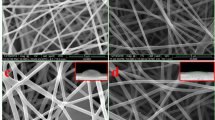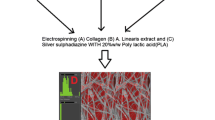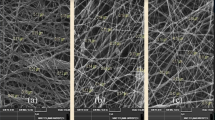Abstract
In this study, styrax liquidus (sweet gum balsam) extracted from Liquidambar orientalis Mill. incorporated PCL fibrous scaffolds were prepared using the electrospinning method. The effects of the styrax liquidus content on the prepared scaffolds were investigated using different physico-chemical and morphological analyses. Then, the styrax-loaded nanofibers were examined for their antioxidant activity, anti-biofilm, metal chelating, antimicrobial and DNA cleavage properties. The results obtained from these studies showed that the nanofibers exhibited effective biological activity depending on the weight ratio of the styrax liquidus. In light of the data obtained from the characterization and biological studies, a sample with high ratio of balsam was built for determining the cytocompatibility analysis in vitro. The cytotoxicity studies of the selected membrane were conducted using mouse embryonic fibroblast cells. The fibrous scaffolds lead to increase the cell number as a result of high viability. According to the results, we propose a novel biocompatible electrospun hybrid scaffold with antioxidant and antimicrobial properties that can be used as wound healing material for potential tissue engineering applications.







Similar content being viewed by others
Data Availability
This article has no additional data.
Code Availability
Not applicable.
References
Gershlak JR, Hernandez S, Fontana G et al (2017) Crossing kingdoms: using decellularized plants as perfusable tissue engineering scaffolds. Biomaterials 125:13–22. https://doi.org/10.1016/j.biomaterials.2017.02.011
Qu M, Jiang X, Zhou X et al (2020) Stimuli-responsive delivery of growth factors for tissue engineering. Adv Healthcare Mater 1901714:1–19. https://doi.org/10.1002/adhm.201901714
Liu S, Zheng Y, Wu Z et al (2020) Preparation and characterization of aspirin-loaded polylactic acid/graphene oxide biomimetic nanofibrous scaffolds. Polymer (Guildf) 211:123093. https://doi.org/10.1016/j.polymer.2020.123093
Sundar G, Joseph J, Prabhakumari C et al (2020) Natural collagen bioscaffolds for skin tissue engineering strategies in burns: a critical review. Int J Polym Mater Polym Biomater. https://doi.org/10.1080/00914037.2020.1740991
Yang X, Wang B, Sha D et al (2020) Injectable and antibacterial ε-poly(L-lysine)-modified poly(vinyl alcohol)/chitosan/AgNPs hydrogels as wound healing dressings. Polymer (Guildf). https://doi.org/10.1016/j.polymer.2020.123155
Pandele AM, Ionita M, Crica L et al (2017) Novel Chitosan-poly(vinyl alcohol)/graphene oxide biocomposites 3D porous scaffolds. Compos B Eng 126:81–87. https://doi.org/10.1016/j.compositesb.2017.06.010
Yar M, Gigliobianco G, Shahzadi L et al (2016) Production of chitosan PVA PCL hydrogels to bind heparin and induce angiogenesis. Int J Polym Mater Polym Biomater 65:466–476. https://doi.org/10.1080/00914037.2015.1129959
Baghaie S, Khorasani MT, Zarrabi A, Moshtaghian J (2017) Wound healing properties of PVA/starch/chitosan hydrogel membranes with nano Zinc oxide as antibacterial wound dressing material. J Biomater Sci Polym Ed 28:2220–2241. https://doi.org/10.1080/09205063.2017.1390383
Güneş S, Tıhmınlıoğlu F (2017) Hypericum perforatum incorporated chitosan films as potential bioactive wound dressing material. Int J Biol Macromol 102:933–943. https://doi.org/10.1016/j.ijbiomac.2017.04.080
Yao Q, Liu Y, Pan Y et al (2020) One-pot porogen free method fabricated porous microsphere-aggregated 3D PCL scaffolds for bone tissue engineering. J Biomed Mater Res B Appl Biomater. https://doi.org/10.1002/jbm.b.34601
Pattanashetti NA, Viana T, Alves N et al (2020) Development of novel 3D scaffolds using BioExtruder by varying the content of hydroxyapatite and silica in PCL matrix for bone tissue engineering. J Polym Res. https://doi.org/10.1007/s10965-020-02053-0
Han R, Buchanan F, Ford L et al (2021) A comparison of the degradation behaviour of 3D printed PDLGA scaffolds incorporating bioglass or biosilica. Mater Sci Eng C 120:111755. https://doi.org/10.1016/j.msec.2020.111755
Tanaka CB, Lopes DP, Kikuchi LNT et al (2020) Development of novel dental restorative composites with dibasic calcium phosphate loaded chitosan fillers. Dent Mater 36:551–559. https://doi.org/10.1016/j.dental.2020.02.004
Sharifi F, Irani S, Azadegan G et al (2020) Co-electrospun gelatin-chondroitin sulfate/polycaprolactone nanofibrous scaffolds for cartilage tissue engineering. Bioact Carbohydr Diet Fibre 22:100215. https://doi.org/10.1016/j.bcdf.2020.100215
Ghorbani M, Nezhad-Mokhtari P, Ramazani S (2020) Aloe vera-loaded nanofibrous scaffold based on zein/polycaprolactone/collagen for wound healing. Int J Biol Macromol 153:921–930. https://doi.org/10.1016/j.ijbiomac.2020.03.036
Garric X, Guillaume O, Dabboue H et al (2012) Potential of a PLA-PEO-PLA-based scaffold for skin tissue engineering: ın vitro evaluation. J Biomater Sci Polym Ed 23:1687–1700. https://doi.org/10.1163/092050611X590912
Cetinkaya S, Cinar I, Dursun HG (2017) Potential effects of Liquidambar orientalis Mill. against HT-29 and HCT-116 cell lines. Proceedings 1:1061. https://doi.org/10.3390/proceedings1101061
Saraç N, Şen B (2014) Antioxidant, mutagenic, antimutagenic activities, and phenolic compounds of Liquidambar orientalis Mill. var. orientalis. Ind Crops Prod 53:60–64. https://doi.org/10.1016/j.indcrop.2013.12.015
Saǧdiç O, Özkan G, Özcan M, Özçelik S (2005) A study on inhibitory effects of siǧla tree (Liquidambar orientalis Mill. var. orientalis) storax against several bacteria. Phyther Res 19:549–551. https://doi.org/10.1002/ptr.1654
Gurbuz I, Yesilada E, Demirci B et al (2013) Characterization of volatiles and anti-ulcerogenic effect of Turkish sweetgum balsam (Styrax liquidus). J Ethnopharmacol 148:332–336. https://doi.org/10.1016/j.jep.2013.03.071
Topal U, Sasaki M, Goto M, Otles S (2008) Chemical compositions and antioxidant properties of essential oils from nine species of Turkish plants obtained by supercritical carbon dioxide extraction and steam distillation. Int J Food Sci Nutr 59:619–634. https://doi.org/10.1080/09637480701553816
Kim J, Seo SM, Lee SG et al (2008) Nematicidal activity of plant essential oils and components from coriander (Coriandrum sativum), oriental sweetgum (Liquidambar orientalis), and valerian (Valeriana wallichii) essential oils against pine wood nematode (Bursaphelenchus xylophilus). J Agric Food Chem 56:7316–7320. https://doi.org/10.1021/jf800780f
Lee Y-S, Kim J, Lee S-G et al (2009) Effects of plant essential oils and components from Oriental sweetgum (Liquidambar orientalis) on growth and morphogenesis of three phytopathogenic fungi. Pestic Biochem Physiol 93:138–143. https://doi.org/10.1016/j.pestbp.2009.02.002
Jeon S, Bose S, Hur J et al (2011) A modified formulation of Chinese traditional medicine improves memory impairment and reduces Aβ level in the Tg-APPswe/PS1dE9 mouse model of Alzheimer’s disease. J Ethnopharmacol 137:783–789. https://doi.org/10.1016/j.jep.2011.06.046
Erdogan E (2019) chemical composition and antimicrobial activity of anatolian sweetgum (Liquidambar orientalis Mill.) leaf oil. Turk J Life Sci 3(2):277–281
Fernandez X, Lizzani-Cuvelier L, Loiseau A-M et al (2005) Chemical composition of the essential oils from Turkish and Honduras Styrax. Flavour Fragr J 20:70–73. https://doi.org/10.1002/ffj.1370
Lingbeck JM, O’Bryan CA, Martin EM et al (2015) Sweetgum: an ancient source of beneficial compounds with modern benefits. Pharmacogn Rev 9:1–11. https://doi.org/10.4103/0973-7847.156307
Okmen G, Turkcan O, Ceylan O, Gork G (2014) The antimicrobial activity of Liquidambar orientalis Mill. Against food pathogens and antioxidant capacity of leaf extracts. Afr J Tradit Complement Altern Med 11:28–33. https://doi.org/10.4314/ajtcam.v11i5.4
Demir D, Güreş D, Tecim T et al (2018) Magnetic nanoparticle-loaded electrospun poly(ε-caprolactone) nanofibers for drug delivery applications. Appl Nanosci 8:1461–1469. https://doi.org/10.1007/s13204-018-0830-9
Bölgen N, Menceloğlu YZ, Acatay K et al (2005) In vitro and in vivo degradation of non-woven materials made of poly(ε-caprolactone) nanofibers prepared by electrospinning under different conditions. J Biomater Sci Polym Ed 16:1537–1555. https://doi.org/10.1163/156856205774576655
Blois MS (1958) Antioxidant determinations by the use of a stable free radical [10]. Nature 181:1199–1200. https://doi.org/10.1038/1811199a0
Hsu CL, Chen W, Weng YM, Tseng CY (2003) Chemical composition, physical properties, and antioxidant activities of yam flours as affected by different drying methods. Food Chem 83:85–92. https://doi.org/10.1016/S0308-8146(03)00053-0
Martínez-Castañón GA, Niño-Martínez N, Martínez-Gutierrez F et al (2008) Synthesis and antibacterial activity of silver nanoparticles with different sizes. J Nanopart Res 10:1343–1348. https://doi.org/10.1007/s11051-008-9428-6
Ceylan S, Göktürk D, Demir D et al (2017) Comparison of additive effects on the PVA/starch cryogels: synthesis, characterization, cytotoxicity, and genotoxicity studies. Int J Polym Mater Polym Biomater 67:1–10
Balu R, Sampath Kumar TS, Ramalingam M, Ramakrishna S (2011) Electrospun polycaprolactone/poly(1,4-butylene adipate-co-polycaprolactam) blends: potential biodegradable scaffold for bone tissue regeneration. J Biomater Tissue Eng 1:30–39. https://doi.org/10.1166/jbt.2011.1004
Jia Y, Huang G, Dong F et al (2016) Preparation and characterization of electrospun poly(ε-caprolactone)/poly(vinyl pyrrolidone) nanofiber composites containing silver particles. Polym Compos 37:2847–2854. https://doi.org/10.1002/pc.23481
Can-Herrera LA, Ávila-Ortega A, de la Rosa-García S et al (2016) Surface modification of electrospun polycaprolactone microfibers by air plasma treatment: effect of plasma power and treatment time. Eur Polym J 84:502–513. https://doi.org/10.1016/j.eurpolymj.2016.09.060
Kuppan P, Sethuraman S, Krishnan UM (2013) PCL and PCL-gelatin nanofibers as esophageal tissue scaffolds: optimization, characterization and cell-matrix interactions. J Biomed Nanotechnol 9:1540–1555. https://doi.org/10.1166/jbn.2013.1653
Hermán V, Takacs H, Duclairoir F et al (2015) Core double-shell cobalt/graphene/polystyrene magnetic nanocomposites synthesized by in situ sonochemical polymerization. RSC Adv 5:51371–51381. https://doi.org/10.1039/c5ra06847a
Eğri Ö, Erdemir N (2019) Production of Hypericum perforatum oil-loaded membranes for wound dressing material and in vitro tests. Artif Cells Nanomed Biotechnol 47:1404–1415. https://doi.org/10.1080/21691401.2019.1596933
Jaganathan SK, Prasath Mani M, Khudzari AZM (2019) Physicochemical assessment of tailor made fibrous polyurethane scaffolds incorporated with turmeric oil for wound healing applications. Int J Polym Anal Charact 24:752–762. https://doi.org/10.1080/1023666X.2019.1676010
Chao CY, Mani MP, Jaganathan SK (2018) Engineering electrospun multicomponent polyurethane scaffolding platform comprising grapeseed oil and honey/propolis for bone tissue regeneration. PLoS ONE 13:1–17. https://doi.org/10.1371/journal.pone.0205699
Unalan I, Slavik B, Buettner A et al (2019) Physical and antibacterial properties of peppermint essential oil loaded poly (ε-caprolactone) (PCL) electrospun fiber mats for wound healing. Front Bioeng Biotechnol 7:1–11. https://doi.org/10.3389/fbioe.2019.00346
Zahedi P, Rezaeian I, Jafari SH, Karami Z (2013) Preparation and release properties of electrospun poly(vinyl alcohol)/poly(É-caprolactone) hybrid nanofibers: optimization of process parameters via D-optimal design method. Macromol Res 21:649–659. https://doi.org/10.1007/s13233-013-1064-z
dos Santos DM, Leite IS, de Bukzem AL et al (2018) Nanostructured electrospun nonwovens of poly(ε-caprolactone)/quaternized chitosan for potential biomedical applications. Carbohydr Polym 186:110–121. https://doi.org/10.1016/j.carbpol.2018.01.045
Assimopoulou AN, Zlatanos SN, Papageorgiou VP (2005) Antioxidant activity of natural resins and bioactive triterpenes in oil substrates. Food Chem 92:721–727. https://doi.org/10.1016/j.foodchem.2004.08.033
Chandra Mohan S, Balamurugan V, Salini ST, Rekha R (2012) Metal ion chelating activity and hydrogen peroxide scavenging activity of medicinal plant Kalanchoe pinnata. J Chem Pharm Res 4:197–202
Brackman G, De Meyer L, Nelis HJ, Coenye T (2013) Biofilm inhibitory and eradicating activity of wound care products against Staphylococcus aureus and Staphylococcus epidermidis biofilms in an in vitro chronic wound model. J Appl Microbiol 114:1833–1842. https://doi.org/10.1111/jam.12191
Kang J, Jin W, Wang J et al (2019) Antibacterial and anti-biofilm activities of peppermint essential oil against Staphylococcus aureus. LWT 101:639–645. https://doi.org/10.1016/j.lwt.2018.11.093
Abdallah M, Khelissa O, Ibrahim A et al (2015) Impact of growth temperature and surface type on the resistance of Pseudomonas aeruginosa and Staphylococcus aureus biofilms to disinfectants. Int J Food Microbiol 214:38–47. https://doi.org/10.1016/j.ijfoodmicro.2015.07.022
Salević A, Prieto C, Cabedo L et al (2019) Physicochemical, antioxidant and antimicrobial properties of electrospun poly(ε-caprolactone) films containing a solid dispersion of sage (Salvia officinalis L.) extract. Nanomaterials. https://doi.org/10.3390/nano9020270
Cetin-Karaca H, Newman MC (2015) Antimicrobial efficacy of plant phenolic compounds against Salmonella and Escherichia coli. Food Biosci 11:8–16. https://doi.org/10.1016/j.fbio.2015.03.002
Kido HW, Oliveira P, Parizotto NA et al (2013) Histopathological, cytotoxicity and genotoxicity evaluation of biosilicate (R) glass-ceramic scaffolds. J Biomed Mater Res. https://doi.org/10.1002/jbm.a.34360
Mehteroğlu E, Çakmen AB, Aksoy B et al (2020) Preparation of hybrid PU/PCL fibers from steviol glycosides via electrospinning as a potential wound dressing materials. J Appl Polym Sci 137:1–13. https://doi.org/10.1002/app.49217
Levorson EJ, Santoro M, Kurtis Kasper F, Mikos AG (2014) Direct and indirect co-culture of chondrocytes and mesenchymal stem cells for the generation of polymer/extracellular matrix hybrid constructs. Acta Biomater 10:1824–1835. https://doi.org/10.1016/j.actbio.2013.12.026
Funding
Not applicable.
Author information
Authors and Affiliations
Contributions
All authors contributed to the study conception and design. Nanofibrous materials preparation, data collection and characterization analysis of samples were performed by DD, BS and NB. Biological activity analysis and data collection were performed by MSY and SÖ. SC performed the cytotoxicity studies and data collection. The first draft of the manuscript was written by DD, SC, MSY, SÖ and NB. All authors commented on previous versions of the manuscript. All authors read and approved the final manuscript.
Corresponding author
Ethics declarations
Conflict of interest
The authors confirm that no conflict of interest occurred in this study.
Additional information
Publisher's Note
Springer Nature remains neutral with regard to jurisdictional claims in published maps and institutional affiliations.
Rights and permissions
About this article
Cite this article
Demir, D., Özdemir, S., Ceylan, S. et al. Electrospun Composite Nanofibers Based on Poly (ε-Caprolactone) and Styrax Liquidus (Liquidambar orientalis Miller) as a Wound Dressing: Preparation, Characterization, Biological and Cytocompatibility Results. J Polym Environ 30, 2462–2473 (2022). https://doi.org/10.1007/s10924-022-02376-7
Accepted:
Published:
Issue Date:
DOI: https://doi.org/10.1007/s10924-022-02376-7




